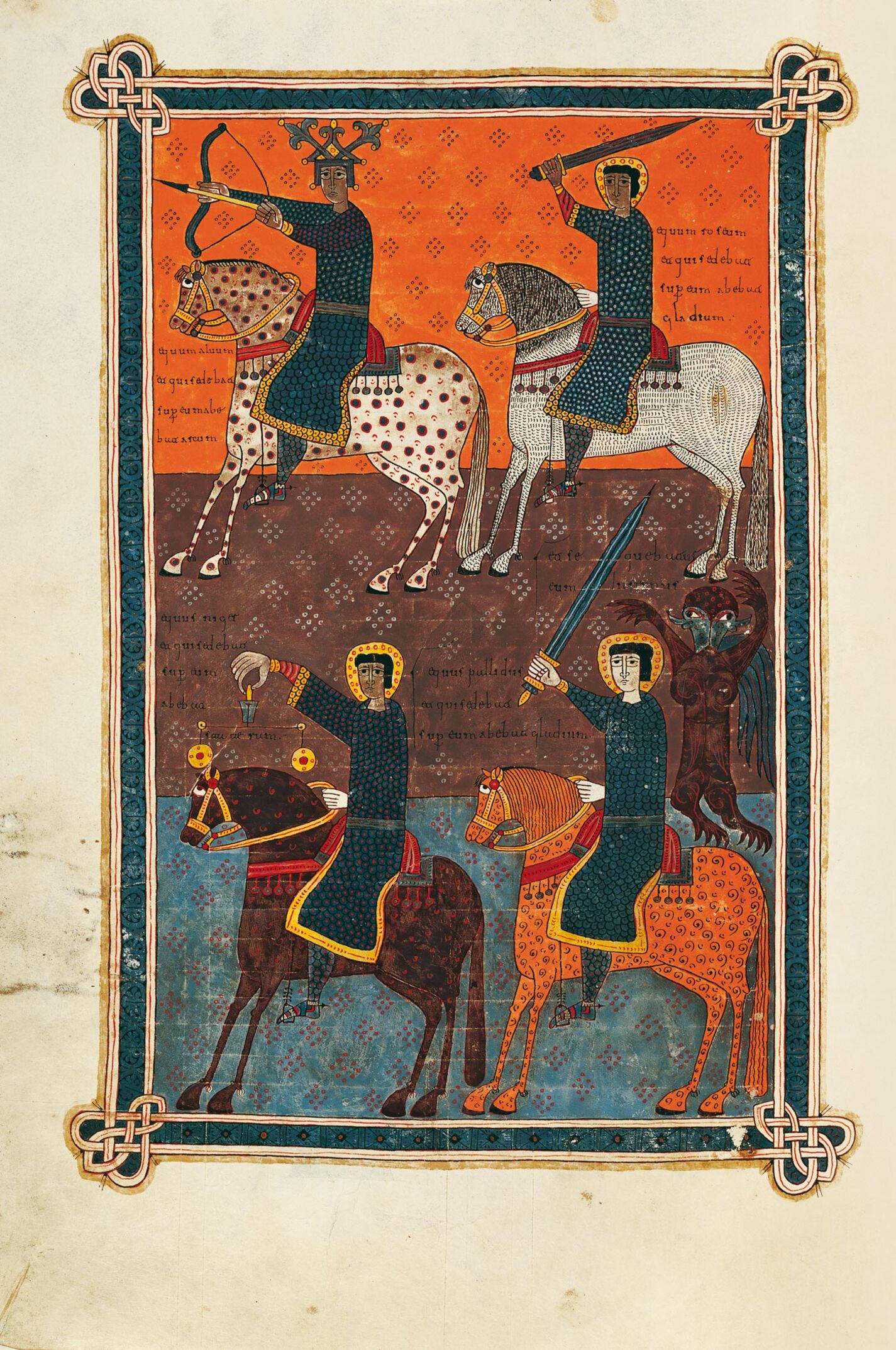The four horsemen of the Apocalypse were a synonym of destruction. Beatus, in line with Victorinus of Pettau and St Jerome in this respect, deemed the crowned horseman riding the white horse to represent the triumphant voice of God: the horse symbolising the Church and the horseman, Christ. This full-folio illustration features a narrative sequence whose earliest version is now to be found in the Valcavado Beatus (f. 93r). It is outlined by a frame featuring an artistic interwoven motif in the corners. The background is divided into three bands – orange, brown and blue moving downwards – with the usual rhombuses formed by little dots covering the surface.
The iconography differs in certain respects from that of the other Beatus codices belonging to stemma IIa, including Valcavado, Urgell (f. 103v) and Fernando I (f. 135r) which do resemble each other. The horses are portrayed walking and therefore lack the liveliness and movement of those depicted galloping. They are arranged two abreast moving towards the left and bearing the attributes assigned to each. The first rider, shooting an arrow, rides not a white (only the one in Urgell is this colour) but a dappled horse like the one in Ferdinand I among others in stemma IIb. The angel placing the crown of conquerors upon his head is missing for he is already wearing an artistic crown. The accompanying legend reads equum aluum / et qui sedebat/ sup[er] eum abe/bat / arcum. The following horseman – a devil covered in blood – rides a pink horse (equum roseum / et qui sedebat / sup[er] eum abe/bat / gladium), in reference to the people opposing the Church. The somewhat blue hue of the horse is suggested by countless fine lines drawn upon a white background. The horseman brandishes a sword overhead in a warlike pose. The third horseman rides a black horse (equus niger / et qui sedebat / sup[er] eum / abebat stateram) in reference to the false prophet and bears the scales. The fourth horseman however, who arises after the Lamb has opened the fourth seal and the voice is heard telling John to “Come and see”, rides an orange horse – not the pale one described in the legend (equus pallidus / et qui sedebat / sup[er] eum abebat / gladium) – and also brandishes a sword. This rider is Death and is empowered to wreak destruction upon earth. Flying behind him, as in the other Beatus belonging to this stemma, is a demon – a synecdoche for Hell. The demon is brown, has round female breasts, wings and limbs ending in claws. The whites of its eyes contrast with its dark colour.
The lavishly dressed horsemen are garbed in the chain mail typical of medieval warriors, open at the sides. Apart from the first horseman, the others have nimbuses. They ride the horses upon Muslim saddles like trappings from which circular pendants hang.

The four horsemen of the Apocalypse were a synonym of destruction. Beatus, in line with Victorinus of Pettau and St Jerome in this respect, deemed the crowned horseman riding the white horse to represent the triumphant voice of God: the horse symbolising the Church and the horseman, Christ. This full-folio illustration features a narrative sequence whose earliest version is now to be found in the Valcavado Beatus (f. 93r). It is outlined by a frame featuring an artistic interwoven motif in the corners. The background is divided into three bands – orange, brown and blue moving downwards – with the usual rhombuses formed by little dots covering the surface.
The iconography differs in certain respects from that of the other Beatus codices belonging to stemma IIa, including Valcavado, Urgell (f. 103v) and Fernando I (f. 135r) which do resemble each other. The horses are portrayed walking and therefore lack the liveliness and movement of those depicted galloping. They are arranged two abreast moving towards the left and bearing the attributes assigned to each. The first rider, shooting an arrow, rides not a white (only the one in Urgell is this colour) but a dappled horse like the one in Ferdinand I among others in stemma IIb. The angel placing the crown of conquerors upon his head is missing for he is already wearing an artistic crown. The accompanying legend reads equum aluum / et qui sedebat/ sup[er] eum abe/bat / arcum. The following horseman – a devil covered in blood – rides a pink horse (equum roseum / et qui sedebat / sup[er] eum abe/bat / gladium), in reference to the people opposing the Church. The somewhat blue hue of the horse is suggested by countless fine lines drawn upon a white background. The horseman brandishes a sword overhead in a warlike pose. The third horseman rides a black horse (equus niger / et qui sedebat / sup[er] eum / abebat stateram) in reference to the false prophet and bears the scales. The fourth horseman however, who arises after the Lamb has opened the fourth seal and the voice is heard telling John to “Come and see”, rides an orange horse – not the pale one described in the legend (equus pallidus / et qui sedebat / sup[er] eum abebat / gladium) – and also brandishes a sword. This rider is Death and is empowered to wreak destruction upon earth. Flying behind him, as in the other Beatus belonging to this stemma, is a demon – a synecdoche for Hell. The demon is brown, has round female breasts, wings and limbs ending in claws. The whites of its eyes contrast with its dark colour.
The lavishly dressed horsemen are garbed in the chain mail typical of medieval warriors, open at the sides. Apart from the first horseman, the others have nimbuses. They ride the horses upon Muslim saddles like trappings from which circular pendants hang.